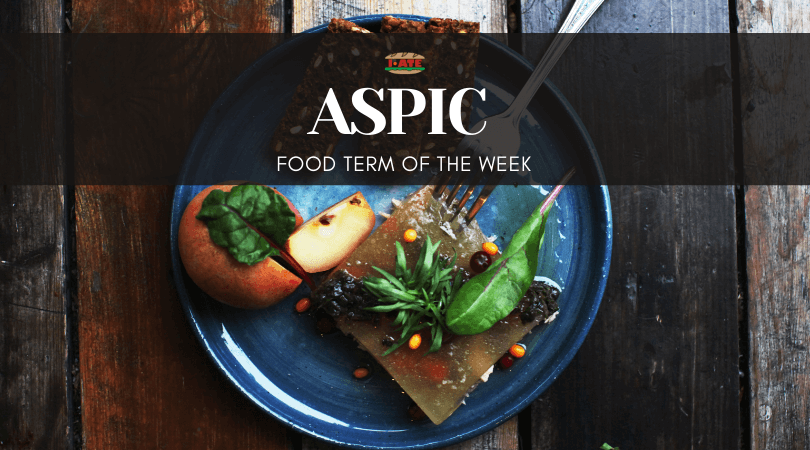 For this week’s I·ATE Food Term we present an unusual dish – aspic. Aspic (Kholodets) is a cold starter, made of meat or fish, bathed in a thick flavoured broth. This dish appeared in Russia and became very popular at the beginning of the 19th century, thanks to the influence of the French culinary school.
For this week’s I·ATE Food Term we present an unusual dish – aspic. Aspic (Kholodets) is a cold starter, made of meat or fish, bathed in a thick flavoured broth. This dish appeared in Russia and became very popular at the beginning of the 19th century, thanks to the influence of the French culinary school.
Yet long before the advent of foreign chefs, Russia was already full of cold snacks and other snacks. The day after a reception, in the noble houses, the remnants of the rich meal of the previous day were mixed with a broth, to be then served cold at the table. The dish was called “galantine en gelée“. Usually, it was prepared from the lower parts of the animal (for example the ox feet, tail or ears) which, after being boiled for a long time, gave this particularly sticky and gelatinous texture. The broth can be clarified with egg white and seasoned before use. Once cooked, it freezes because of the natural gelatin contained in the meat. Almost all types of food can be put in aspics, pieces of meat, vegetables, fruits etc. Aspics are usually served on cold plates to prevent the gel from melting before eating.
Here some historical facts about aspic and other jelly dishes:
• In the Middle Ages, cooks discovered that a thickened meat broth could be turned into jelly. Meat jellies were cooked before fruit or vegetable jellies.
• Aspic was used as a “hot cold” sauce, with cold fish or poultry preparations. It added mellowness and flavour.
• Gelatin dishes, such as aspic or tomato jelly, arrived in the United States in the early 20th century and were extremely popular in the 1950s. Cooks showed their aesthetic skills by inventing dishes based on aspics.
Nowadays, in some European countries, pork or poultry aspic is a very popular Christmas and Easter dish. In Asia, especially among the Newar people, buffalo aspic is a major dish at winter festivals. It is made with dried fish, buffalo, condiments and spices. There are different versions and names of aspic across whole Europe. Let’s check them out!
Germany: sülze
Belarus: kvashanina
Bulgaria: patcha
Croatia: hladetina
Estonia: sült
Finland: aladobi
Hungary: kocsonya
Latvia: gallerts or aukstā gaļa
Lithuania: šaltiena
Macedonia: pivtija or pača
Poland: galareta
Romania: piftie or răcituri
Russia: kholodets or studen
Serbia: pihtije
Sweden: aladåb
Ukraine: kholodets, studenets
Though aspic is an old dish and it almost vanished from our collective menu. Yet it seems to be fun to give it a try!
Have a nice weekend and tune in next week for another I·ATE instalment!
Sources:
• http://www.myrecipes.com/extracrispy/what-is-aspic
• https://www.theguardian.com/lifeandstyle/wordofmouth/2010/apr/30/aspic
• https://en.wikipedia.org/wiki/Aspic
Written by Krystina Garibyan – Communication Study Visitor at the Terminology Coordination Unit of the European Parliament (Luxembourg) and a student of the Master Program in Learning and Communication in Multilingual and Multicultural Contexts at the University of Luxembourg. She holds a BA in Information and Communication from the University of Nice. She speaks English, Russian, French and Spanish.

